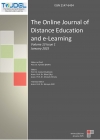TOJDEL - Volume 1 - Issue 1 - January 2013
 ├óŌé¼┼ōFacts or Fantasy├óŌé¼┬Ø, Implementing Podcast Based Supplemental Instruction in An Open Distance Learning Context: The Case of The Univerisity of South Africa (Unisa)
├óŌé¼┼ōFacts or Fantasy├óŌé¼┬Ø, Implementing Podcast Based Supplemental Instruction in An Open Distance Learning Context: The Case of The Univerisity of South Africa (Unisa) Maria Madiope, Masabata Ranko-Ramaili
Abstract: This study explores the feasibility of implementing a supplemental instruction (SI) programme at Unisa using audio podcasting technology. It addresses high failure and dropout rates among first-year students enrolled in ├óŌé¼┼ōhigh-risk├óŌé¼┬Ø modules. A designation of ├óŌé¼┼ōhigh risk├óŌé¼┬Ø for a module makes no prejudicial comment about the course lecturer/s or students; it merely denotes that over an extended period a sizeable number of students enrolled in these modules fail to meet the expected level of performance. The study aligns itself with Unisa├óŌé¼Ōäós drive towards the creative use of technology, as it proposes podcasting as a channel for SI. SI is aimed at helping students registered in ├óŌé¼┼ōat-risk├óŌé¼┬Ø modules to develop the use of metacognitive skills and enhancing their motivation and academic performance, thus becoming more independent and proactive learners. Since participation in SI is completely voluntary, not all students might volunteer to participate. At the end of the first semester or year of implementation of SI, evaluation will be undertaken to establish whether there is a significant difference between the performance of SI participants and non-participants. Both groups of students will be invited to reflect on their experiences of the module/s. These students├óŌé¼Ōäó participation in other interventions such as e-tutoring would not stop.
 Development and Acceptance Evaluation of Personalized Classroom Response System
Development and Acceptance Evaluation of Personalized Classroom Response System Gwo-Dong Chen, Tsun Ku , Chia-Yu Chen, Chih-Kai Chang
Abstract: Learning technology greatly modifies traditional classroom teaching methods due to the continuous development and innovation of information technology and wireless network technology. The integration of an interactive response system in traditional classrooms can improve the interaction between teachers and students; the classroom response system (CRS) can store students├óŌé¼Ōäó response data and save assessment time. However, the current application of CRS in practice exams has many disadvantages. For example, the traditional CRS used to allow students to input their responses using small remote transmitters that send signals to a receiver and wait for other classmates to complete their responses; moreover, the CRS cannot provide adaptive individuals├óŌé¼Ōäó supplementary information. Therefore, the study aimed to develop a personalized interactive response system (IRS) to facilitate both teaching activities and personal learning assessment in a classroom setting; students are required to use mobile learning devices (i.e. tablets as interactive tools, a platform for instant assessment, and e-readers). Through the wireless network, pop quizzes, or learning activities can be performed to increase interactions between teachers and students and conduct remedial teaching instantly. The system can shorten waiting time for students and stimulate reflection of what they learn in practice exams, increase the readability of questions, and provide privacy when answering questions. The study recruited 6th graders of an elementary school as participants to investigate the usability and users├óŌé¼Ōäó acceptance of the system. The results indicate the differences between the traditional CRS and the personalized IRS and recommend applicable learners based on the results of the cross verification between different personality preferences and users├óŌé¼Ōäó acceptance. The collected feedback from the participants and teachers can be referred for further studies.
 Enhancing social interaction in massive professional English courses
Enhancing social interaction in massive professional English courses Elena B├ā┬Īrcena, Timothy Read, Mar├ā┬Ła Jordano
Abstract: This paper describes the long way undergone in UNED, the Spanish national distance university, in the last ten years to improve our teaching of the English language with the assistance of computers and, more specifically, with the emerging web technologies. There are a number of milestones in this long way, such as the development of the aLF in house platform from the early MIT dotLearn which allowed students and teachers to engage in English only interaction, either as part of the usual educational routine or as part of teaching innovation networks, i.e., projects undertaken by volunteering students, sometimes with students from other language subjects, degrees or universities. For years all this work was written and there was little chance for students to develop their oral capabilities. The incorporation of UNED├óŌé¼Ōäós webconferencing system and the AVIP-PRO tool enabled asynchronic evaluation of oral production and interactive skills. One of the increasing problems of UNED, the unbalanced ratio between students (300,000) and teaching staff (1,500) has found a very promising option in dynamic organization and social networks, whereby large groups are automatically split into small groups with an advanced student as monitor who assumes a number of conventional teacher├óŌé¼Ōäós tasks, such as providing feedback, correcting errors, controlling the group collaborative dynamics, etc. The role of monitor is assigned by a rather simple procedure of social labelling, an idea half way between web 2.0 and gamification. This paper describes UNED├óŌé¼Ōäós experiences with the application of all these technologies to English language distance learning.
 The Best On-Line Guidance Experiences in Finnish Primary School Teacher Education Practicum
The Best On-Line Guidance Experiences in Finnish Primary School Teacher Education Practicum Merja Meril├ā┬żinen, P├ā┬żivi Valli, Raine Valli, Maarika Piispanen
Abstract: Finnish primary school teacher education is built on master level studies since the late 70├é┬┤s. Teachers├óŌé¼Ōäó profession and pedagogical skills will grow not only during university studies but also in guided training practicums in Finnish primary schools and special training schools. Never the less, Finnish school system is not problem free ├óŌé¼ŌĆ£ approximately ten percent of new teachers will change their career in the first five teaching years. This is a strong signal about the challenges connected to teacher├óŌé¼Ōäós profession nowadays also in Finland despite the great success in international student achievement tests (PISA). In recent years, there has been an increasing interest in supporting and mentoring just graduated teachers during the induction period. Could this be done already during the studies? This paper will focus on the final practicum period in Kokkola University Consortium├é┬┤s primary school teacher education program. The purpose of this paper is to seek modern ways to guide and support pre-service teachers during their first working months in Finnish primary schools already during the late studies. In this essay we will highlight both student├é┬┤s and teacher├é┬┤s experiences concerning on-line quidance and support system in the final practicum period shortly before graduation.
 Comparison of Reflective Thinking Profiles of Individuals using Social Networks for Education in terms of Time Variable
Comparison of Reflective Thinking Profiles of Individuals using Social Networks for Education in terms of Time Variable Korhan KAYI├ģ┼ŠLI, Tuncay SEV├ä┬░ND├ä┬░K, Hanbey HAZAR
Abstract: Throughout the history, to find information has not been so easy but this situation has changed after development of computer and internet technology. There are some methods using technology and internet developed in the education field parallel with them. These methods developed as an alternative to traditional training methods have been improving themselves to increase the interaction between educator and student, achieve meaningful data from accumulated data that occur as a result of the data exchange. At this point, development of the information, skills, creative thinking, problem solving, reflective thinking and critical thinking of participants, students, educators and network leaders have been gaining importance day by day. To think effectively, consistently and carefully of the information, any belief or knowledge support the results aimed by them emerges as the reflective thinking. The information and the number of users is so much in social networks and this situation reveals that the reflective thinking skills should take an active role in these networks. In this study, it is aimed to bring out and compare the reflective thinking skills and profiles of the participants in social networks. A 28-item questionnaire was adapted and prepared to determine of 511 social network users├óŌé¼Ōäó reflective thinking profiles in terms of the time variable. The obtained data were analyzed with statistical methods (t-test, frequency, percent) by using spss software.


